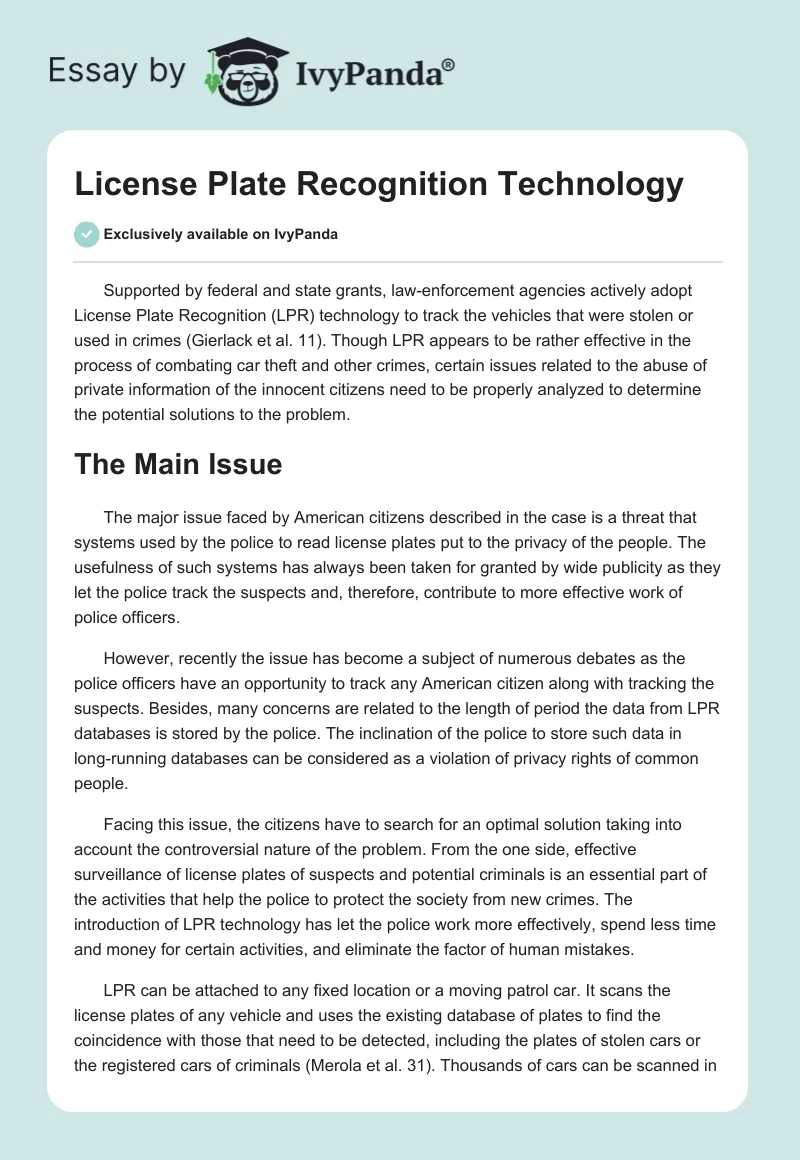Supported by federal and state grants, law-enforcement agencies actively adopt License Plate Recognition (LPR) technology to track the vehicles that were stolen or used in crimes (Gierlack et al. 11). Though LPR appears to be rather effective in the process of combating car theft and other crimes, certain issues related to the abuse of private information of the innocent citizens need to be properly analyzed to determine the potential solutions to the problem.
The Main Issue
The major issue faced by American citizens described in the case is a threat that systems used by the police to read license plates put to the privacy of the people. The usefulness of such systems has always been taken for granted by wide publicity as they let the police track the suspects and, therefore, contribute to more effective work of police officers.
However, recently the issue has become a subject of numerous debates as the police officers have an opportunity to track any American citizen along with tracking the suspects. Besides, many concerns are related to the length of period the data from LPR databases is stored by the police. The inclination of the police to store such data in long-running databases can be considered as a violation of privacy rights of common people.
Facing this issue, the citizens have to search for an optimal solution taking into account the controversial nature of the problem. From the one side, effective surveillance of license plates of suspects and potential criminals is an essential part of the activities that help the police to protect the society from new crimes. The introduction of LPR technology has let the police work more effectively, spend less time and money for certain activities, and eliminate the factor of human mistakes.
LPR can be attached to any fixed location or a moving patrol car. It scans the license plates of any vehicle and uses the existing database of plates to find the coincidence with those that need to be detected, including the plates of stolen cars or the registered cars of criminals (Merola et al. 31). Thousands of cars can be scanned in a short period, and if the match is made, a police officer receives a signal and proceeds with further actions.
Therefore, LPR makes the process that previously was conducted manually automated and much more cost- and time-effective (Merola et al. 31). The advantages given to the police by the usage of LPR technology encouraged most of police agencies to acquire and use it. The technologies enabling the police to store individuals’ travel data and even link it to other databases are also developing and actively used by appropriate institutions (Merola et al. 30).
Besides being used in home policing, LPR is also effectively used for a war-zone surveillance and contributes to the efficacy of the global war on terrorism (Cousineau 74). Therefore, while considering the issue of the usage of LPR technology, great benefits given by it to the law enforcement institutions providing public safety should not be underestimated.
From the other side, the numerous advantages of LPR technology can be overshadowed by the potential violation of rights for privacy it can provoke. As the data collected by LPR includes information about common citizens and can be stored for many years, certain concerns about the access to the private information about any citizen given to the police arise. LPR technology is not only a scanner, as it also presents an information technology system.
The amount of data it stores can be used for future record management and analysis, including confirming a suspect’s alibi (Merola et al. 31). However, no one can guarantee that the data on ordinary people that do not present any interest to criminal investigations will not be accessed and abused.
LPR technology lets the police discover which church you attend, what entertainment places you visit, and where you spend your leisure time based on the analysis of the collected data. Therefore, besides being an important investigative tool, LPR can become a source of severe violation of citizens’ rights for private life.
Underscoring the Issues
The case underscored the discussed issue from the perspective of considering LPR technology as a tool that enables official institutions to collect data on American citizens.
The text emphasizes the fact that LPR databases are used not only for tracking criminals, suspects, or stolen cars but also for storing extensive amounts of information about innocent people who present no special interest for the police. The text draws the reader’s attention to the fact that the police officers are willing to have an opportunity to use long-running databases and keep an eye on the information about any citizen.
Besides exploring the specifics of the negative side of LPR and its influence on the process of ensuring the security of the citizens’ privacy, the text also presents valuable information about the ways of decreasing the risks related to usage of LPR. Using LPR database only for the purposes of criminal investigation and storing the data about innocent people only for limited periods are regarded as the necessary rules that should be followed by the police and governmental institutions to eliminate the risks of violating people’s privacy.
Besides, the information about the usage of LPR technology should be public, and any citizen should be able to acquire the information about which data related to his private life is currently stored in the databases. Preventing sharing of the data collected by law enforcement institutions with the third parties is also considered necessary. The text of the case underscores the potential danger of misusing LPR technology by the police and reveals the possible solutions that can help to prevent abuse of citizens’ private information.
Society Position on the Issue
The issue discussed in the text directly affects the security of private life of the members of society. Therefore, searching for effective solutions to deal with the problem related to usage of LPR technology by the police should include assessing of the overall awareness of the citizens of the issue and their position on it.
As the case raises numerous questions about the threat put by LPR technology to the privacy of American citizens, it naturally causes the readers to question whether common citizens are aware of being subjects of constant license plate surveillance provided by LPR all over the country. Merola and Lum conducted a study aimed at revealing the level of public awareness about the usage of LPR and its influence on the life of people (119).
The results of the study show that most members of the society have heard about LPR, but do not know much about the technology (Merola and Lum 123). The majority of people do not possess any information about whether their local police department uses LPR technology for scanning license plates or not (Merola and Lum 123).
However, when the participants of the survey were asked to define whether main pieces of information collected by LPR readers (date, time, location of vehicle, and it license plate number) should be regarded as private or public, nearly half of the respondents defined this data as private (Merola and Lum 123).
The survey conducted by Merola and Lum also reveals that nearly twenty percents of participants are inclined to change their usual behavioral patterns if they know their cars are constantly scanned by LPR readers (125). This fact demonstrates how severely LPR technology can affect the life of people. Most of the participants of the survey indicated that police should be required to obtain certain special permission to have access to the data collected by LPR readers (Merola and Lum 125).
Therefore, it is obvious that the notion discussed in the case text corresponds to the citizens’ position on the issue. However, the government successfully employs public relations professionals to find the most effective ways of using the concept of lobby groups in practice. Therefore, it can be rather difficult to deal with the discussed issue, as much effort is put in ensuring that the tools used for citizens’ surveillance will not be dismissed.
The Primary Lesson
The primary lesson to be learned from the issue presented in the case text is related to the necessity to raise public awareness of the opportunities of tracking innocent citizens given to the police by LPR technology and databases. The society should be actively involved in the process of providing the efficient regulation of the activities that suggest the usage of LPR by the police.
This lesson shows the necessity of assessing the citizens’ awareness of usage of LPR to track their license plates and the attitude of common people toward such practice. Though numerous specialists express their concerns about the usage of LPR readers and support the notion that the law forcing police officers to get a warrant from a judge prior to accessing LPR databases, the majority of citizens do not participate in the debates on the issue (Abdollah par. 4).
Informing people about the role LPR technology can play in opening up many opportunities for abuse of private information is of vital importance, as tracking of citizens’ locations can turn the private information about the political or religious events they attend, the doctors they visit, and people they meet into public (“You Are Being Tracked” par. 5).
Therefore, only effective activities aimed at raising the awareness about the possible abuse of information collected by LPR readers can encourage the creation of clear regulations that can keep the government from keeping an eye on the private life of the citizens.
The effectiveness of using LPR technology for combating car theft and other crimes is unquestionable. However, the discussion of certain problems related to the abuse of private information of the innocent citizens in the text encourages further investigation of the issue. The lesson learned from the issue demonstrates the urgent necessity to educate the society about the privacy issues related to LPR and enforce the creation of appropriate regulations.
Works Cited
Abdollah, Tami. Private Database Lets Police Skirt License Plate Data Limits. 2015. Web.
Cousineau, Matt. “The Global War on Terror and Automatic License Plate Recognition.” Canadian Review of Sociology 50.1 (2013): 74-88. Print.
Gierlack, Keith, Shara Williams, Tom LaTourette, James Anderson, Lauren Mayer, and Johanna Zmud. License Plate Readers for Law Enforcement: Opportunities and Obstacles, Santa Monica, California: Rand Corporation, 2014. Print.
Merola, Linda, and Cynthia Lum. “Emerging Surveillance Technologies: Privacy and the Case of License Plate Recognition (LPR) Technology.” Judicature 96.3 (2012): 119-126. Print.
Merola, Linda, Cynthia Lum, Breanne Cave, and Julie Hibdon. “Community Support for License Plate Recognition.” Policing: An International Journal of Police Strategies & Management 37.1 (2014): 30-51. Print.
You Are Being Tracked: How License Plate Readers Are Being Used to Record Americans’ Movements. Web.


